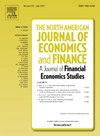引入新的脆弱性指数,评估资产泡沫事件中的金融稳定性
IF 3.8
3区 经济学
Q1 BUSINESS, FINANCE
North American Journal of Economics and Finance
Pub Date : 2024-09-24
DOI:10.1016/j.najef.2024.102291
引用次数: 0
摘要
本文致力于开发一种创新的脆弱性指数,旨在全面捕捉以资产泡沫为特征的时期的金融稳定动态。本研究利用多方面的方法框架,首先识别泡沫的发生,并计算出 delta CoVaR 系统性风险指标。然后,我们以既定的宏观经济方法为基础,提出了量化金融泡沫对新兴市场稳定性影响的指标。具体来说,我们根据对罗马尼亚 20 家流动性最好的公司财务稳定性的每日观察,构建了两个重合指标。第一个指标来源于这些公司的 CoVaR 三角洲值,第二个指标则是利用一个模型的残差计算得出的,该模型采用了相同的金融稳定性指标作为因变量,并以代表资产泡沫存在的二进制变量作为解释因素。第二个重合指标跟踪的是没有泡沫效应时的金融稳定性。这两个指标之间的差异构成了创建 "泡沫脆弱性指数 "的基础,该指数衡量金融稳定性对资产泡沫的整体易感性。在罗马尼亚市场的背景下,本研究表明,资产泡沫时期与系统性风险上升有关。我们的研究结果表明,泡沫的存在大大加剧了金融风险因素,为严重的市场调整和经济衰退创造了有利条件。我们确定了脆弱性达到峰值的具体时间段,包括 2018 年 6 月至 9 月、2018 年 12 月至 2019 年 3 月、2020 年 3 月和 2022 年 3 月。本文章由计算机程序翻译,如有差异,请以英文原文为准。
Introducing a novel fragility index for assessing financial stability amid asset bubble episodes
This paper is devoted to the development of an innovative fragility index designed to capture comprehensively the dynamics of financial stability during periods characterized by asset bubbles. Utilizing a multifaceted methodological framework, the study begins by identifying bubble occurrences and calculating the delta CoVaR systemic risk metric. Building on established macroeconomic methodologies, we then propose an indicator to quantify the impact of financial bubbles on the stability of an emerging market. Specifically, we construct two coincident indicators based on daily observations of financial stability for the twenty most liquid Romanian companies. The first indicator is derived from the delta CoVaR values of these companies, while the second is computed using the residuals of a model that employs the same financial stability metric as the dependent variable, with a binary variable representing the presence of asset bubbles as the explanatory factor. This second coincident indicator tracks financial stability in the absence of bubble effects. The disparity between these two indicators forms the basis for the creation of an index, termed the “bubble fragility index,” which measures the overall susceptibility of financial stability to asset bubbles. In the context of the Romanian market, this study demonstrates that periods marked by asset bubbles are associated with elevated systemic risks. Our findings indicate that the presence of bubbles significantly intensifies financial risk factors, creating conditions conducive to severe market corrections and economic downturns. We identify specific intervals during which fragility reaches peak levels, including June to September 2018, December 2018 to March 2019, March 2020, and March 2022.
求助全文
通过发布文献求助,成功后即可免费获取论文全文。
去求助
来源期刊
CiteScore
7.30
自引率
8.30%
发文量
168
期刊介绍:
The focus of the North-American Journal of Economics and Finance is on the economics of integration of goods, services, financial markets, at both regional and global levels with the role of economic policy in that process playing an important role. Both theoretical and empirical papers are welcome. Empirical and policy-related papers that rely on data and the experiences of countries outside North America are also welcome. Papers should offer concrete lessons about the ongoing process of globalization, or policy implications about how governments, domestic or international institutions, can improve the coordination of their activities. Empirical analysis should be capable of replication. Authors of accepted papers will be encouraged to supply data and computer programs.

 求助内容:
求助内容: 应助结果提醒方式:
应助结果提醒方式:


